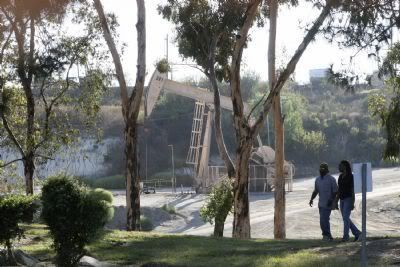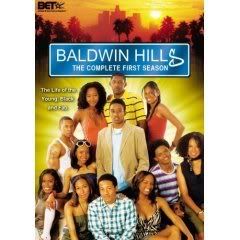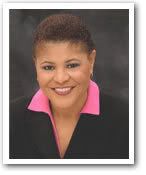"Drill, baby, drill!" - was a popular cheer at the 2008 Republican National Convention. It's a parody of "Burn, baby, burn," the infamous cry during the 1965 Watts rebellion in Los Angeles. Ironically, it was former Maryland Lt. Gov. Michael Steele, one of the Republican Party's very few prominent black politicians, leading the cheer for the riot of the privileged:
"So, do you want to put your country first? Then let's reduce our dependency on foreign sources of oil and promote oil and gas production at home. In other words: Drill, baby, drill! And drill now!"
Baldwin Hills in Los Angeles, View Park, Windsor Hills, and Ladera Heights, are some of the most prominent middle-class African-American neighborhoods in the United States. Blacks are more than 70% of Baldwin Hills' population. After Blacks began moving there in the 1960s, it was nicknamed the "Golden Ghetto" and the "Black Beverly Hills." It has been home to celebrities like Ray Charles, Nancy Wilson, Tina Turner and the late Los Angeles Mayor, Tom Bradley. Black Entertainment Television (BET) used the setting for the "Baldwin Hills" television show.
The Fight Over the Baldwin Hills Oil Field
(Visit: www.baldwinhillsoil.org)
The two-square-mile Baldwin Hills Oil Field is the last large-scale undeveloped open space in South and West Los Angeles. The Oil Field has operated since 1924. Over time, it naturally becomes harder to extract oil for old wells until at some point they become unprofitable. In recent years the field had almost played out. As the oil companies have left, a large area has been designated the Kenneth Hahn State Recreation Area. For years, the old field and the surrounding nice residential neighborhoods coexisted. But this is the era when everything you ever thought you could rely on from American business - job security, health care, pensions, or even honest accounting - is old fashioned.
Plains Exploration and Production Company (PXP) based in (where else?) Houston, Texas wants to drill up to 1,000 new wells over the next 20 years. Next week there will be what is expected to be a contentious public hearing:
Los Angeles County Planning Commission
Wednesday, September 10, 2008
Hall of Administration,
Room 381B
500 West Temple Street
Los Angeles, CA 90012
PXP has been packing hearings with their employees while public comment has been severely limited. It time for the entire California Green Movement to get involved in this fight.
Environmental Impact Report
The Baldwin Hills area has included oil and gas production since the 1920s, when the area was largely underdeveloped. Today, the oil field operates in the middle of a densely-populated urban area. The Oil Field has operated since 1924 without community oversight or an Environmental Impact Report (EIR) to assess its impact on community health and safety.
In 2006, the Los Angeles County Board of Supervisors placed a temporary restriction on drilling new oil wells or deepening existing wells. That restriction expired on June 28, 2008 just as a Draft Environmental Impact Report (EIR) was released by the County. The oil field operator, Plains Exploration and Production Company (PXP), proposes to expand the drilling. The 60-day public comment period for the Draft EIR was set to expire on August 19. Representatives from community groups such as the Greater Baldwin Hills Alliance (GBHA), Mujeres de la Tierra , Culver Crest Neighborhood Association, and others have all petitioned for additional time to review the 800-plus pages of the Draft EIR.
Community Standards District
A Community Standards District (CSD) is a site specific zoning ordinance setting standards and regulations on oil drilling and production. It sets forth the conditions under which drilling can occur, while providing a mechanism to increase public oversight, monitoring, enforcement and accountability.
The Greater Baldwin Hills Alliance recommendations include:
- Eliminate potential health risks and environmental impacts associated with the oil field operation through consolidation
- Provide enforceable environmental and health protections including monitoring sanctions and penalties
- Provide for the clean up and eventual transition of the land to parkland consistent with the Baldwin Hills Park Master Plan
- Support residential living, open space, recreation, schools, critical habitats and improve the current aesthetics of the oil field
- Establish oversight from a multi-sector advisory committee including residents.
More on Baldwin Hills and African-Americans in L.A.
From The City Project Web Site
Professor Josh Sides describes the unique role of the Baldwin Hills in the history of African Americans in Los Angeles and across the nation:
By the late 1950s and early 1960s, blacks had pushed west and south of West Adams into Leimert Park and the exclusive area of Baldwin Hills, which quickly became the heart of affluent black Los Angeles, a position it still holds today. A five-square-mile area of unincorporated hillside west of Leimert Park/ Crenshaw and south of West Adams, Baldwin Hills boasted large homes and expansive views. Largely undeveloped until the 1940s, hundreds of houses and apartment complexes were built there in the 1950s. As they had in Compton, blacks moved into new and large homes, with an average of four to six bedrooms per household. African Americans in Baldwin Hills were generally much better educated than their South Central counterparts, a fact that translated into greater job opportunities in the post-boom economy.
Accordingly, just over 71 percent of all employed African Americans in Baldwin Hills were white-collar workers. . .
In addition to superior housing, residents of Baldwin Hills and the nearby Leimert Park and Crenshaw areas also enjoyed many more conveniences as consumers. While many Watts and Willowbrook residents were forced to buy groceries at overpriced liquor stores, Baldwin Hills residents had other options. The Crenshaw Shopping Center, opened in 1947, as one of the first planned suburban malls in the United States, was the most popular shopping area for local residents. And, during the 1960s, the Baldwin Hills Center and the Ladera Center also opened, offering residents even greater selection and convenience. . .
Perhaps the greatest advantage to residing in Baldwin Hills was the superior quality of the area's public schools. In 1971, the Los Angeles Department of City Planning described Baldwin Hills public schools as the "the best schools of any city area inhabited primarily by black people" and on par with those in West Los Angeles and the San Fernando Valley." In addition to boasting low dropout rates and small class sizes relative to public schools in Watts and South Central, public schools in Baldwin Hills were also more racially integrated. . .
Environmental Hazards
There is a delicate balance between the interests of the oil company to harvest local oil wells and maintaining the environment for people living in surrounding communities.

A couple enjoys trail in a state park in the Baldwin Hills just a few steps away from a PXP oil pump. Photo from Los Angeles WAVE, September 4, 2008.
The by-products of oil production include: Benzene, Toluene, Ethylbenzene, and Xylene, collectively know as BTEX. Getting the crude oil from the ground in old wells requires water into the ground to force the crude oil to the surface. This creates an empty space or movement of a fault line. Also, extracting oil causes gases to rise to the surface through fault lines.
"Backyard bonanza or environmental time bomb?"
by Gregg Reese, Our Weekly, July 3 - July 6, 2008
Mark Salkin became involved in this issue as the president of the Culver City Crest Home Owners Association two and a half years ago, when the Plains Exploration & Production Company (PXP), which currently owns the Baldwin Hills extraction field, struck a methane deposit in the process of drilling for oil. The subsequent link made several residents sick (with out any fatalities), and the county became involved with allegations that PXP was not observing environmental safety guidelines.
Salkin told Our Weekly that he was given a personal tour of the oil facility by PXP Vice President Steve Rusch a few years ago, and observed numerous sites in production or in an exploratory mode. . .
derricks in the area are out in the open for all to see, with little or no cosmetic enhancement. All this is in sharp contrast to pumps located in Beverly Hills (where image is paramount), say critics. One notable well sits right next to Beverly Hills High encased in a ten story structure that has been artfully decorated as well as sound proofed to mask the gyrations of the contraption inside. Derricks in other parts of the southland from Long Beach to West L.A. have been tastefully obscured via shrubbery or other methods of camouflage. . .
Why Baldwin Hills? Why Now? -- Sending a Message Ain't Nothing Gonna Change
Last year, Bill Boyarsky reported on Truthdig.com that this area was not only a rich source of votes and support for Sen. Barack Obama, but also a source of significant campaign donations.
"Listening to America's Black Middle Class"
By Bill Boyarsky, Truthdig, October 11, 2007.
I got interested in the middle-class contributions while digging into the Obama campaign.
A couple of longtime black politicians told me that the size of Obama contributions from their community was big. "I've never seen so many African-Americans with a lot of money," one of them said. "I didn't know there was that much wealth."
The phenomenon is occurring in prosperous black areas across the country. A few months ago, USA Today surveyed political giving in nearly 600 ZIP codes that included a substantial number of African-American households with incomes above the black national median household income of $31,000 a year. Obama received about 70 percent of the contributions.
I looked at an area I know, View Park and Windsor Hills in Los Angeles. This is not the bleak black and Latino L.A. so beloved by filmmakers, television stations and newspapers which immerse themselves almost exclusively in black crime and other tragedies. Big, luxurious homes adorn this hillside several miles northwest of the poor neighborhoods in the South Los Angeles flatlands. View Park and Windsor Hills are 88 percent black, with a median household income of $73,118, the U.S. Census reported, more than the Los Angeles County household total of $51,447. Almost 70 percent of the people living there are families.
. . .
What is as interesting as the horse race is the nature of the Obama contributors. Among them in Los Angeles' View Park and Windsor Hills are a producer, a chief executive officer of a business consulting company, a nationwide bank senior vice president, lawyers and a restaurant owner.
California state Sen. Mark Ridley-Thomas, who is campaigning for Obama, said the Illinois senator's message resonates strongly with such people. "His vision of hope and morality and basic centrist politics is grounded in a moral sensibility that is hard to argue with," Ridley-Thomas said.
Today State Sen. Ridley-Thomas and City Councilman Bernard Parks are competing for an open seat on the Los Angeles County Board of Supervisors. Ridley-Thomas backed Obama early when most of California's prominent Black Democrats were backing Sen. Hillary Clinton. Blogger Ari L. Noonan wryly noted that Councilman Parks
"lives within sniffing distance of the Baldwin Hills oil field." Parks has been embarrassed by the disclosure that he accepted a campaign contribution from PXP in his last campaign for mayor.
 After African-Americans began moving into Baldwin Hills in the 1960s, it was nicknamed the "Golden Ghetto" and the "Black Beverly Hills." It has been home to celebrities like Ray Charles, Nancy Wilson, Tina Turner and the late Los Angeles Mayor, Tom Bradley. Black Entertainment Television (BET) used the setting for the "Baldwin Hills" television show.
After African-Americans began moving into Baldwin Hills in the 1960s, it was nicknamed the "Golden Ghetto" and the "Black Beverly Hills." It has been home to celebrities like Ray Charles, Nancy Wilson, Tina Turner and the late Los Angeles Mayor, Tom Bradley. Black Entertainment Television (BET) used the setting for the "Baldwin Hills" television show.  In the California State Assembly, this area is represented by Karen Bass, another big Obama supporter and the first African-American woman to serve as speaker of a state assembly in the history of the United States.
In the California State Assembly, this area is represented by Karen Bass, another big Obama supporter and the first African-American woman to serve as speaker of a state assembly in the history of the United States. Two points.
First, this is exactly the sort of community all the Democratic and Republican hacks pretend to love whenever they rant and foam about the supposedly "forgotten" hard-working, tax-paying, law-abiding, American middle class. Second, this specific community is second only to the Hyde Park section of Chicago as the heart of Barack Obama Country.
Corporate America is sending a message that for all the talk about "change! change! change!" from the one corporate party with two names, ain't nothing gonna change and it will be business as usual on January 20th.
From "Burn, Baby, Burn" in 2001 to "Drill, Baby, Drill" in 2008.
In 2001, California was plunged into an unprecedented energy crisis: rolling blackouts, soaring power bills, a panicked state government. Turned out the Golden State was being systematically ripped-off. Documents and audiotapes proved Houston-based Enron Corporation asked power companies to take plants offline - in order to make more money. In one taped phone call, an Enron employee celebrated the fact that a massive forest fire had shut down a transmission line:
ENRON EMPLOYEE 1: Yeah.
ENRON EMPLOYEE 2: Now, the magical word of the day is "Burn, baby, burn."
ENRON EMPLOYEE 1: What's happening?
ENRON EMPLOYEE 2: There's a fire under the core line. This will delay us from 45 to 2,100.
ENRON EMPLOYEE 1: Really. Burn, baby, burn!
When Michael Steele cried "Drill, Baby, Drill!" to the GOP faithful, maybe he wasn't thinking about Watts in 1965. Maybe he was thinking about Enron's battle cry in 2001.
Less than a decade later, thanks to the terrifying spike in oil prices, the energy greedheads and carbon pushers are trying to stampede Californians into accepting offshore oil drilling and new drilling in old wells even though all the experts agree this will have no impact on the global marketplace for oil. As I write this, the "Drill, Baby, Drill" crowd is pushing hard for offshore drilling in Santa Barbara, Long Beach, Monterey Bay, and even off Point Reyes (see www.environmentcalifornia.org).
And always, always, they try to divide us and rule us by playing off class, religious, and "racial" differences.
Will you let them get away with it?
5 comments:
Thanks for bringing this up, Alex. When I heard that chant at the RNC, when I watched a news interview with one of the attendees and saw he face light up as he repeated those words, I became pretty depressed.
This will be as important to having a Green Future in CA as even solving the Water Crisis in the Delta.
It is time that we make politicians admit the truth, that you can not exploit energy in that manner without putting this entire state in jeopardy.
The time is short in trying to organize things, but it would be wonderful to see Cynthia at that hearing along with about 1000 LA Greens. Barring that, just the 1000 LA Greens would be enough to get on the evening news.
Short notice... let's see how much can we accomplish.
The Baldwin Hills Oil Fields have taken the time to educate themselves on the health and environmental impacts of the proposed expansion of oil drilling in the Baldwin Hills Parklands, followed up on that action by engaging their government at the city.
--------
smithsan
seo
As the oil companies have left, a large area has been designated the Kenneth Hahn State Recreation Area.More info
This was greeat to read
Post a Comment